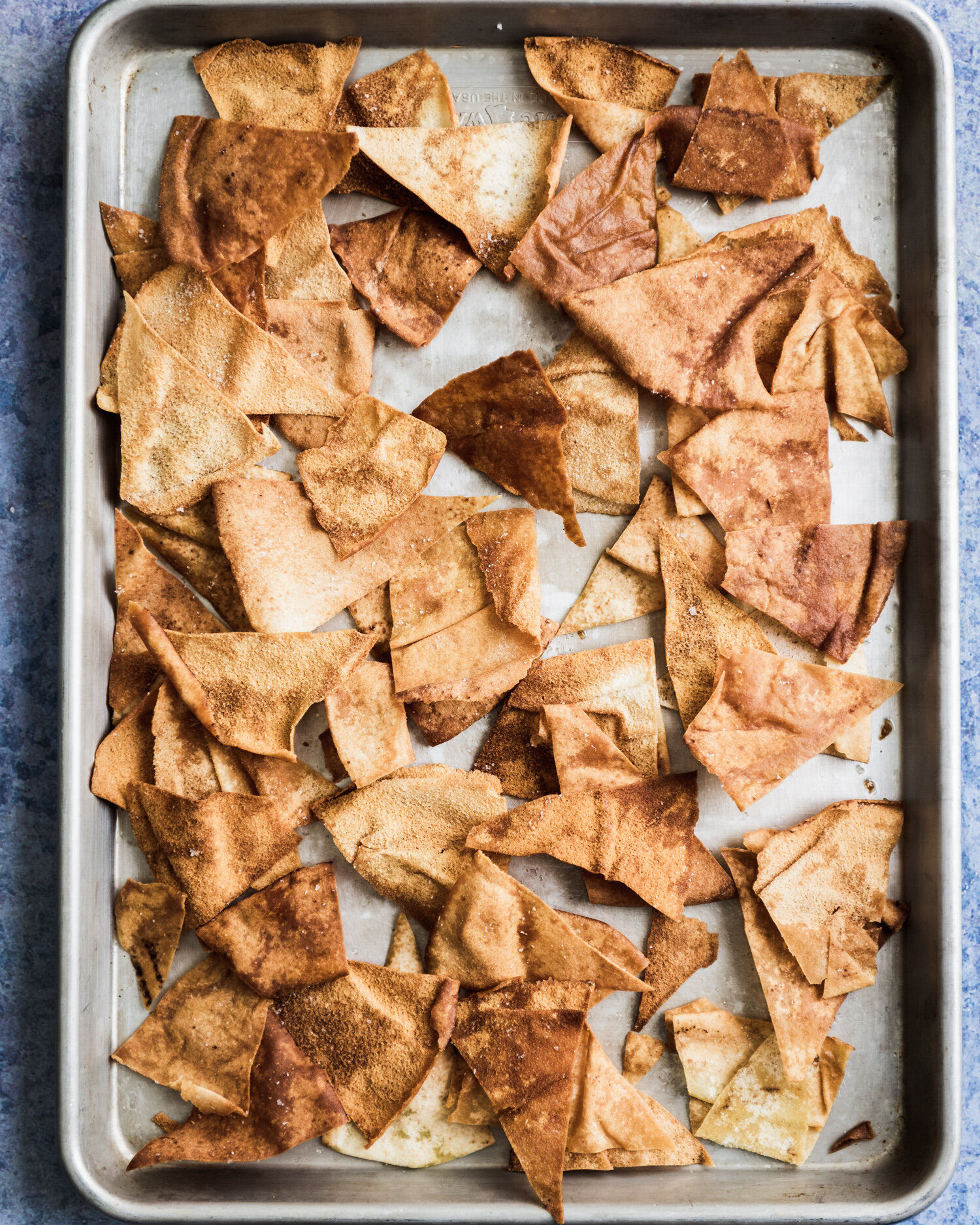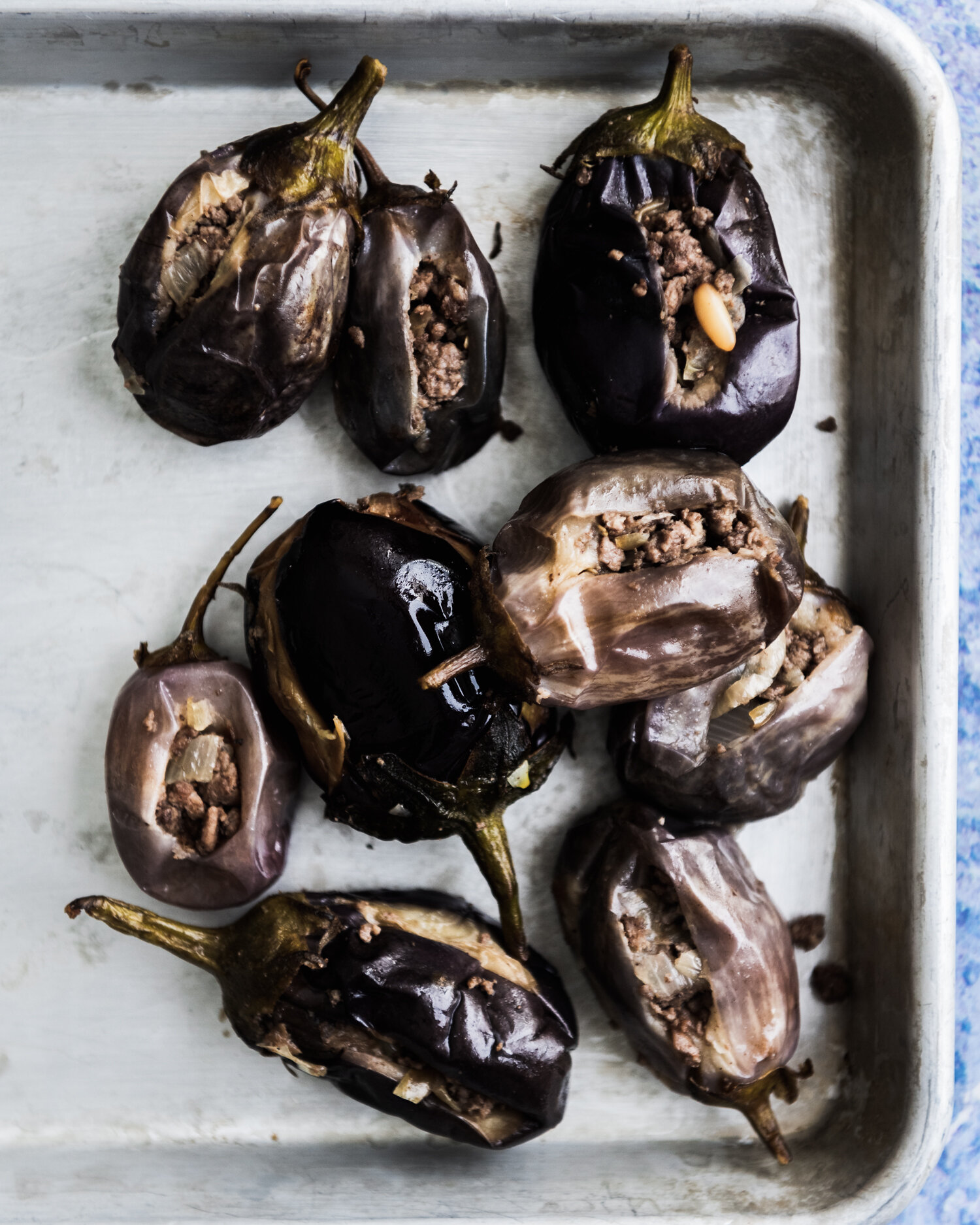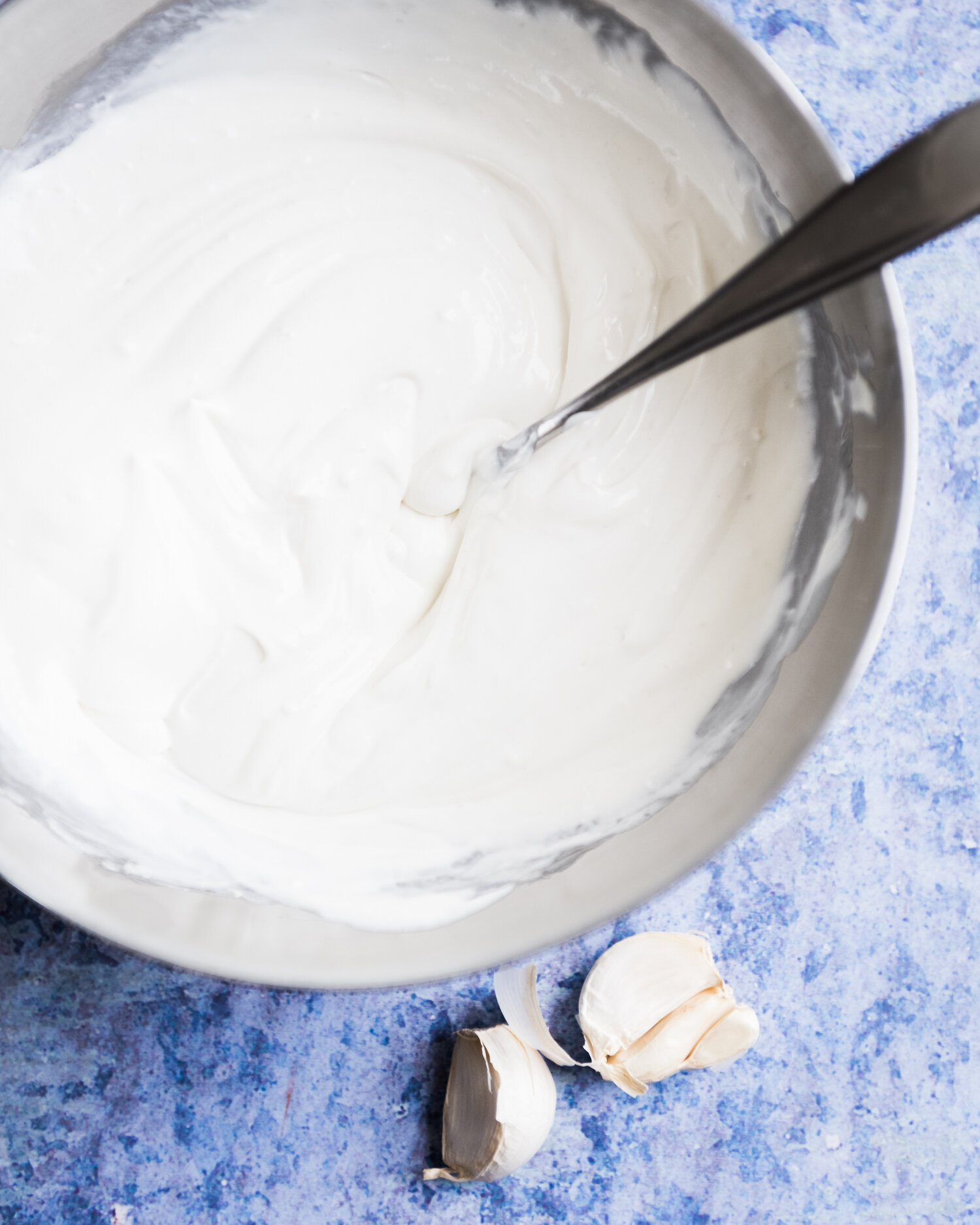Jump to Recipe
Today I’m sharing Fattet Makdous, or Stuffed Baby Eggplants with Crispy Bread, Yogurt and Tomato Sauce. With a few additional steps and special touches, this one is undoubtedly the best you will ever have.
Before I decided to cook Arabic food, I was so intimidated. Each dish has so many components and layers of flavor. When I first published this post in 2018, fatteh felt so scary and time consuming, but I dove straight in with fattet makdous, or stuffed eggplant fatteh. Fatteh best translates to “crushed” or “crumbs,” and it includes day-old bread fried and mixed with toppings. It’s made all over the Levant region of the Middle East, but fattet makdous is specifically Syrian.
After being exposed to other Arabic recipes and cooking aside from my mother’s, I’ve learned that my mother’s is the best. I know, I know, everyone says that about their mom, and I’m not here to ruffle any feathers. But trust me: there are a few techniques that she’s taught me that truly elevate it to a whole other level, and I’m so excited to pass them onto you!
When I first made it, this dish took the better part of a day to make, but once I bit into the deliciously creamy fried and stuffed eggplant combined with the tangy yogurt and tomato sauce with crunchy bread, I felt so accomplished. Now, I’ve mastered the art of Arabic prep cooking so assembly is super easy. I made sure to specify the make-ahead components and time frame.
Let’s talk about the ingredients. The foundation is the crispy bread. Traditionally, day-old pita bread is cut into pieces and pan or deep fried. It’s a great way to use up old bread, since it keeps in an airtight container on the counter for weeks. Lately I prefer to bake my pita crisps, and it’s just as tasty. A thicker version of pita works best, but the thin stuff is just fine if that’s all you have.
This dish is best made with in-season baby eggplants. They vary in flavor and quality tremendously. I like to take out the bitter seeds with an apple corer, keeping most of the flesh intact, but you can also very easily slice a little crevice or pocket into the side for the filling. Both work great, and I use the two methods interchangeably. The cored eggplant will deep fry with the filling, while the slit eggplant will fry pre-filling.
The filling is a classic sheikh al mehshi stuffing of ground meat, Syrian 7 spices, onions, and pine nuts. Each component is prepared separately. Is that totally necessary? Well, most people cook the meat and onions together, but this method really ensures the onions cook down until nice and sweet and the meat is evenly browned. It only adds maybe 10 more minutes of cooking time but lots more flavor.
My mom, every summer, cans fresh, overripe tomatoes for use in sauce throughout the year. The tomato sauce for fattet makdous is best prepared with high-quality canned or jarred tomato sauce. If you can’t find any, whole tinned peeled tomatoes will work great, and you can crush them with your hands. The addition of pomegranate molasses adds a nice sweet and sour component. Cooking the sauce with the eggplants really ensures that the flavors meld together beautifully.
Most people use yogurt, but we’re using labneh, or strained yogurt, for its silky texture and tanginess. The addition of garlic and tahini provide a nice balance.
The crispy fried garlic topping is my mom’s secret weapon. Think of it like a homemade condiment. I’m sure you will use it on just about everything (i.e. pizza, eggs, shakshouka, other dishes, etc.).
Additional toasted pine nuts are totally optional, but strongly recommended.
Everything can be prepared at least 1-2 days ahead of time and assembled just before serving, either room temperature as mezze/appetizers or with warmed tomato sauce as a main course.
My suggestion? Make the ground meat mixture in the beginning of the week and use the leftovers in various ways (i.e. make sambousek, toss it in omelets, or top hummus). Fry the eggplant and make the pita crisps that same day. Before serving, maybe the next day, the day after that, or maybe even the day after, while the tomato sauce cooks, whip together the labneh mixture, and then assemble it all together.
I hope you give this recipe a try! If you do, don’t forget to put it in the comments to let everyone know how it works out. I also love to see your creations. You can tag me on social media at #omayahcooks and @omayah.atassi.
Other eggplant recipes:
Pan-Fried Eggplant with Tangy Garlic Cilantro Sauce
Stuffed Eggplants in Garlic Yogurt Sauce (Sheikh Mshatah)
Eggplant and Tomato Casserole (Mnazelet Betinjan)
Batersh (Smoked Eggplant with Tomato Sauce)
Kawaj (Syrian Summer Vegetable Medley)
Other fatteh posts:
Syrian Fattet Makdous vs. Palestinian Fattet Makdous
Fattet Jaj (Chicken with Crispy Pita, Warmed Yogurt and Rice)
Chickpeas with Crispy Pita, Warmed Yogurt and Caramelized Garlic (Fattet Hummus)
*This post and recipe was originally published on October 31, 2018 and has been updated with pictures and information.
Fattet Makdous (Stuffed Baby Eggplants with Crispy Bread, Yogurt, and Tomato Sauce)
Ingredients
- 1 lb ground beef or lamb
- 1 tsp Arabic 7 spices, or 3/4 tsp all spice and 1/4 tsp cinnamon
- 1 large onion, chopped finely
- 2 tbsp olive oil
- 1/3 c pine nuts, plus about 2 tbsp for serving
- 1/2 tbsp butter
- 12 baby eggplants (estimate 2-3 per person)
- 1 L neutral cooking oil (vegetable, sunflower, etc.)
- 2 large brown onions
- 2 tbsp olive oil
- 3 14-oz./400 ml jars of fresh tomato sauce or whole peeled tomatoes
- 1/4 c pomegranate molasses (to taste)
- 1 pint/500 g labneh (strained yogurt)*
- 1 tbsp tahini
- 1 garlic clove, smashed or minced finely
- 2 loaves of day-old thick Arabic or pita bread
- 2 tbsp of olive oil (if baking) or 500 ml sunflower oil (if frying)
- 4 garlic cloves, minced finely
- 1/4 c vegetable or sunflower oil
- 1/4 c minced parsley for serving
Instructions
- Place a large skillet on medium heat. Add the finely chopped onion and olive oil. Cook, stirring occasionally, until the onion is soft, past translucent, and light golden.
- Wipe down the pan and return it to the stove on high heat. Add the ground beef or lamb and constantly “chop” the meat with a wooden spoon while it cooks to break up into fine pieces. The meat will start to release juices and then will dry up and turn deep brown .
- Melt the butter in a small saucepan set over medium heat. Add the pine nuts and stir constantly until they turn a delicious golden brown.
- In a large bowl, combine the onions, ground meat, and pine nuts. Season with 1 teaspoon of 7 Spices, 1 teaspoon of salt and pepper to taste. Allow to cool and store in an air-tight container in the fridge if using later.
- Slice the top off the eggplants and core them with an apple corer. When you core them, be sure to just get the center with the seeds. You still want to leave a lot of the inside intact because that’s what makes this dish tasty.
- Alternatively, make a slit on the side of each eggplant, deep enough to stuff them but not sliced all the way through.
- If cored, stuff the eggplants with the ground meat mixture, making sure you really push the stuffing in there with your thumb so you can fit as much as possible.
- Fill a stock pot with about 1-1.5 inches neutral cooking oil with a high smoke point, I use sunflower. Heat the oil to about 350° F/180° C, or if a grain of rice is dropped in, it rises to the top and starts cooking immediately. Fry about 2-3 minutes per side, or until golden, being careful not to overcrowd the pan.
- If you fried slit eggplants, you can stuff them at this point by putting the ground meat mixture in the crevice.
- Stuffed and fried eggplants can be stored in the fridge in an air-tight container for about 3 days. They also freeze really well at this point in zip top bags.
- Grab a pan that’s deep and wide, like a dutch oven. Preheat ~2 tbsp olive oil over medium heat.
- Add the onions and a pinch of salt, cook until nice and golden, about 20 mins.
- If using canned whole tomatoes, place in a large bowl and crush with your hands. Add them and their juices or the jarred tomato sauce and simmer together covered for about 20 minutes or until the acidity from the tomato sauce has cooked off and it's thickened.
- Turn off the heat. Add the pomegranate molasses and adjust seasoning to balance out the flavors (sweet/sour with pomegranate molasses, roundedness with salt).
- You can store the sauce in an air-tight container for a few days at this point or continue cooking.
- Cut the bread into wedges.
- If frying, add enough oil in a pan so that it's about 1/2 inch deep. Bring to 350° F/180° C and add the bread in batches until its a deep golden, about 30 seconds. Drain on a paper towel-lined plate.
- Alternatively, to bake, heat an oven to 425° F/218° C and spread the bread evenly onto a baking sheet. Toss in a couple tbsp of olive oil and a sprinkling of salt. Put it in the oven for about 7-8 minutes, tossing once to ensure it's evenly crispy and brown.
- Combine the labneh, tahini and garlic paste.
- If your labneh is quite thick, you might need to add a bit of water. It should be loose enough to toss with the bread later.
- Salt to taste.
- Preheat the vegetable oil in a small saucepan and add the garlic, swirling constantly, until a deep golden brown, being careful not to burn.
- Drain, reserving the oil. Store the garlic and oil separately in the fridge.
- Bring the sauce to a gentle simmer on the stove. Place the eggplant in a baking dish, pour the sauce on top, cover with foil, and roast in a 350° F/180° C oven for about 20-30 minutes until the eggplant turns silky and soft. (If you're pressed for time, you can skip this step. Just warm the sauce on the stove, slide the eggplant in, and simmer covered for about 5 minutes until heated through)
- Bring the labneh mixture to room temperature.
- In a deep serving platter, layer the bread and labneh mixture. Toss around to combine.
- Add 2-3 ladles of the warm tomato sauce. Fish the eggplant out and layer on top, and top with the remaining sauce.
- Top with reserved pine nuts (if using), the fried garlic, a drizzle of its oil, and the chopped parsley.
- Enjoy immediately.
Notes:
*If you can't find labneh near you, it's quite simple to make your own. Line a colander with a couple layers of paper towel and place over a large bowl. Mix 1 kg/2 lb yogurt with 1 tsp salt. Pour over the paper towel-lined colander and allow to strain for about a day. On the counter is fine, but it will work in the fridge if that makes you feel irksome.







